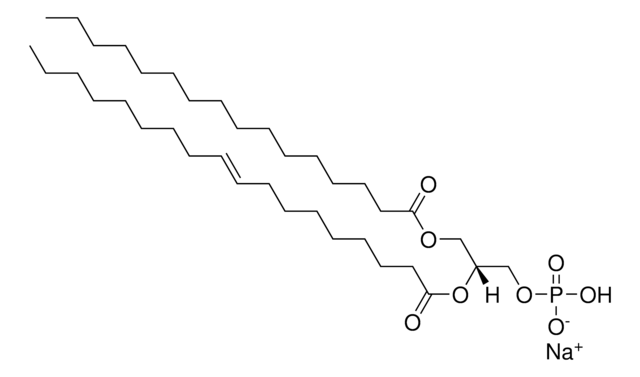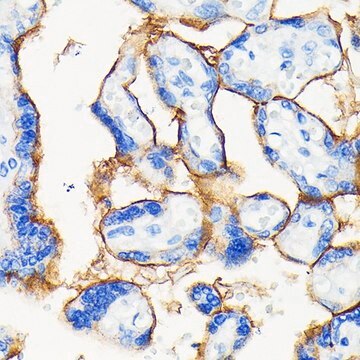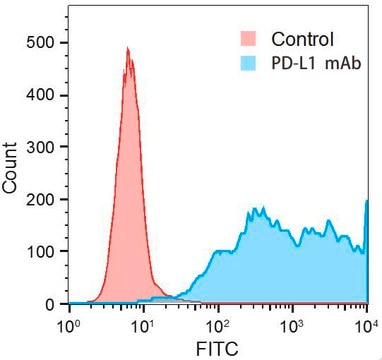HTS089M
ChemiSCREEN Membrane Preparation Recombinant Human LPA1 Lysophospholipid Receptor
Human LPA1 / EDG2 GPCR membrane preparation for GTPγS binding Assays.
Anmeldenzur Ansicht organisationsspezifischer und vertraglich vereinbarter Preise
Alle Fotos(1)
About This Item
UNSPSC-Code:
41106514
eCl@ss:
32161000
NACRES:
NA.84
Empfohlene Produkte
Allgemeine Beschreibung
Human EDG2 encoding LPA1
Lysophosphatidic acid (LPA) is a lysophospholipid produced by activated platelets that inhibits adenylate cyclase and stimulates DNA synthesis, changes in cell morphology, and increases in intracellular calcium in a variety of cultured mammalian cells. A family of three GPCRs, LPA1, LPA2 and LPA3, mediates the biological effects of LPA (Contos et al., 2000). LPA1 is widely expressed, with particularly notable expression in the ventricular zone of the embryonic cerebral cortex. Mice lacking LPA1 exhibit craniofacial abnormalities and defective development of the cerebral cortex (Harrison et al., 2003; Choi et al., 2008). LPA1 also promotes fibrotic responses to tissue injury (Tager et al., 2008)
Millipore′s LPA1 Membrane Preparation is a crude membrane preparation made from the proprietary stable recombinant cell line that is also used for Millipore’s LPA1 Calcium Optimized Cell Line (HTS089C). This LPA1 Membrane Preparation exhibits both constitutive and agonist-induced activity in GTPγS binding assays; thus it is an ideal HTS tool for screening of compounds for agonist, inverse agonist, and antagonist activities. The membrane preparations exhibits EC50 of 73 nM for LPA in a GTPγS binding assay.
Millipore′s LPA1 Membrane Preparation is a crude membrane preparation made from the proprietary stable recombinant cell line that is also used for Millipore’s LPA1 Calcium Optimized Cell Line (HTS089C). This LPA1 Membrane Preparation exhibits both constitutive and agonist-induced activity in GTPγS binding assays; thus it is an ideal HTS tool for screening of compounds for agonist, inverse agonist, and antagonist activities. The membrane preparations exhibits EC50 of 73 nM for LPA in a GTPγS binding assay.
Anwendung
GTPγS binding assay
Biochem./physiol. Wirkung
GPCR Class: A
Protein Target: LPA1 / EDG2
Target Sub-Family: Lysophospholipid
Qualität
1 unit = 5 μg
EC50 in GTPγS binding assay by LPA: ~ 73 nM
EC50 in GTPγS binding assay by LPA: ~ 73 nM
Spezifikationen
Inucbation Conditions
GTPγS ASSAY CONDITIONS: Membranes are permeabilized by addition of saponin to an equal concentration by mass, then mixed with [35S]-GTPγS (final concentration of 0.3 nM) in 20 mM HEPES, pH 7.4/100 mM NaCl/10 mM MgCl2/10 μM GDP in a nonbinding 96-well plate. Unlabeled ligand was added to the final concentration indicated in Figure 1 (final volume 100 μL), and incubated for 30 min at 30°C. The binding reaction is transferred to an FB filter plate (Millipore MAHF B1H) previously prewetted with water. The plate is washed 3 times (1 mL per well per wash) with cold 10 mM sodium phosphate, pH 7.4, then dried and counted.
GTPγS ASSAY CONDITIONS: Membranes are permeabilized by addition of saponin to an equal concentration by mass, then mixed with [35S]-GTPγS (final concentration of 0.3 nM) in 20 mM HEPES, pH 7.4/100 mM NaCl/10 mM MgCl2/10 μM GDP in a nonbinding 96-well plate. Unlabeled ligand was added to the final concentration indicated in Figure 1 (final volume 100 μL), and incubated for 30 min at 30°C. The binding reaction is transferred to an FB filter plate (Millipore MAHF B1H) previously prewetted with water. The plate is washed 3 times (1 mL per well per wash) with cold 10 mM sodium phosphate, pH 7.4, then dried and counted.
Physikalische Form
One package contains enough membranes for at least 200 assays (units), where one unit is the amount of membrane that will yield greater than 1000 cpm specific LPA-stimulated [35S]-GTPγS binding.
Liquid in packaging buffer: 50 mM Tris pH 7.4, 10% glycerol and 1% BSA with no preservatives.
Packaging method: Membrane protein was adjusted to the indicated concentration in packaging buffer, rapidly frozen, and stored at -80°C.
Liquid in packaging buffer: 50 mM Tris pH 7.4, 10% glycerol and 1% BSA with no preservatives.
Packaging method: Membrane protein was adjusted to the indicated concentration in packaging buffer, rapidly frozen, and stored at -80°C.
Lagerung und Haltbarkeit
Store at –70°C. Product is stable for at least 6 months from the date of receipt when stored as directed. Do not freeze and thaw.
Rechtliche Hinweise
CHEMICON is a registered trademark of Merck KGaA, Darmstadt, Germany
Haftungsausschluss
Unless otherwise stated in our catalog or other company documentation accompanying the product(s), our products are intended for research use only and are not to be used for any other purpose, which includes but is not limited to, unauthorized commercial uses, in vitro diagnostic uses, ex vivo or in vivo therapeutic uses or any type of consumption or application to humans or animals.
Lagerklassenschlüssel
12 - Non Combustible Liquids
WGK
WGK 2
Flammpunkt (°F)
Not applicable
Flammpunkt (°C)
Not applicable
Analysenzertifikate (COA)
Suchen Sie nach Analysenzertifikate (COA), indem Sie die Lot-/Chargennummer des Produkts eingeben. Lot- und Chargennummern sind auf dem Produktetikett hinter den Wörtern ‘Lot’ oder ‘Batch’ (Lot oder Charge) zu finden.
Besitzen Sie dieses Produkt bereits?
In der Dokumentenbibliothek finden Sie die Dokumentation zu den Produkten, die Sie kürzlich erworben haben.
Unser Team von Wissenschaftlern verfügt über Erfahrung in allen Forschungsbereichen einschließlich Life Science, Materialwissenschaften, chemischer Synthese, Chromatographie, Analytik und vielen mehr..
Setzen Sie sich mit dem technischen Dienst in Verbindung.








